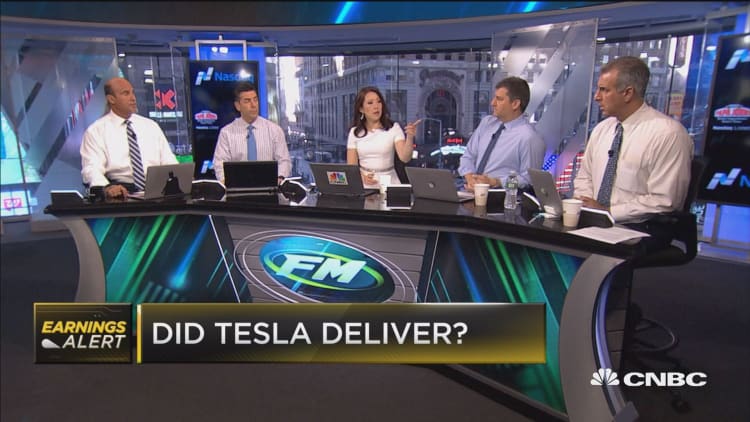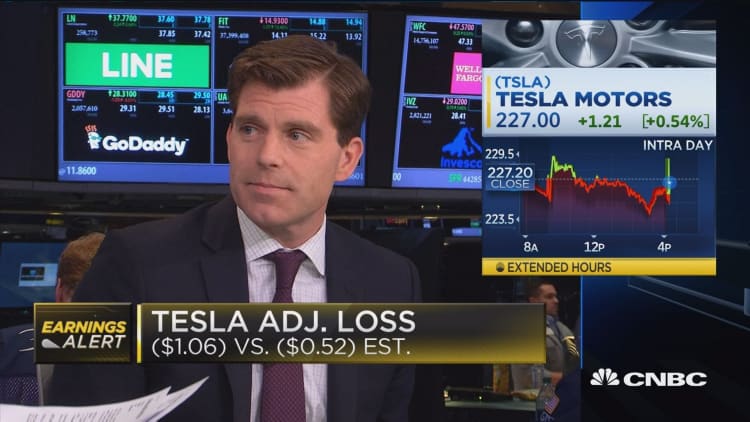


Although Tesla fell far short of Wall Street estimates for earnings and revenue, the company showed progress in increasing its production capabilities, which have long been an issue for the electric auto maker.
With these improvements, Tesla said it is on track to deliver 50,000 vehicles in the latter half of this year, which reaffirms its previous guidance.
Tesla shares wavered in trading after the closing bell.
The company reported a second-quarter adjusted loss of $1.06 per share on $1.56 billion in sales. That's more than double the loss analysts, on average, were expecting. Thomson Reuters' consensus estimate called for a loss of 52 cents a share on revenue of $1.62 billion.
Telsa also continued to burn through cash as it invested in production improvements and the construction of its gigafactory in Nevada. But its cash position improved and stood at $3.25 billion as of June 30, fueled in part by a $1.7 billion offering in May. The company expects to log another $2.25 billion in capital expenditures this year to support its accelerated Model 3 production schedule.
Despite these results, Tesla investors remain much more focused on next year rather than these near-term earnings, said Ben Kallo, a senior research analyst at Robert W. Baird.
"I think this is actually what I call de-risking the quarter," Kallo told CNBC. "We got the quarter out of the way so now we got a couple months where Elon can start telling us more about the Model 3."
Kallo is looking for the new model to be introduced in the back half of this year, and when it is, it will be a positive catalyst for the stock.
Tesla said Wednesday it completed the design phase for its Model 3, which it is being marketed as a more affordable version of its high-end cars. Some production equipment for the Model 3 is ready, and Tesla expects to begin building the body and general assembly centers later this year.
After the Model 3, the next priority will be developing the Model Y, a small crossover vehicle, CEO Elon Musk said during the company's earnings conference call. Musk said he expects strong demand for this vehicle in the range of 500,000 to 1 million units a year.
14,402 vehicles delivered in 2Q
In a letter to shareholders, Tesla said that it finished the second quarter consistently making 2,000 vehicles per week. For the entire quarter, Tesla produced a record total of 18,345 vehicles, an 18 percent increase over the first quarter and up 43 percent over the second fiscal quarter of 2015. Nearly half of the cars it produced occurred in the final four weeks of the quarter.
Tesla said it delivered 14,402 new vehicles, consisting of 9,764 Model S and 4, 638 Model X, which was higher than the company stated in its July production update.
With the improvements in vehicle production efficiency, Telsa said it expects to make 2,200 vehicles a week by the end of the third quarter, and 2,400 a week by the end of the fiscal year.
Meanwhile, new vehicle orders rose 67 percent over the same quarter last year.
Tesla also is seeing increased demand from customers who want to lease their vehicles, and it expects direct leasing to rise from 8 percent of deliveries in the second quarter to about 15 percent of deliveries in the third quarter. While this trend is not surprising given the high cost of the Model S and Model X, Tesla will need to strike new deals with lenders to fund the program.
In its letter to shareholders, Telsa said it had reached its funding limit with a banking partner for its leasing program, but it expects to add new partners in order to continue to sign new leases.
The construction schedule for the Gigafactory manufacturing facility is on track to support volume Model 3 production in late 2017, the company said.
Favorable pricing for the Model S, which rose 3 percent sequentially, and improved manufacturing for the Model X, helped Tesla report "strong" sequential gross margin increases. On a GAAP basis, its automotive gross margin was 23.1 percent. On a non-GAAP basis, gross margins increased 200 basis points from first-quarter to 21.9 percent.
More to come on autonomous drive technology
There has been some talk among analysts that a new version of autonomous drive technology might be rolled into the Model 3 when it is unveiled later this year.



